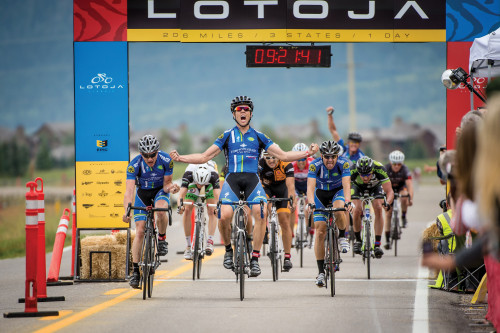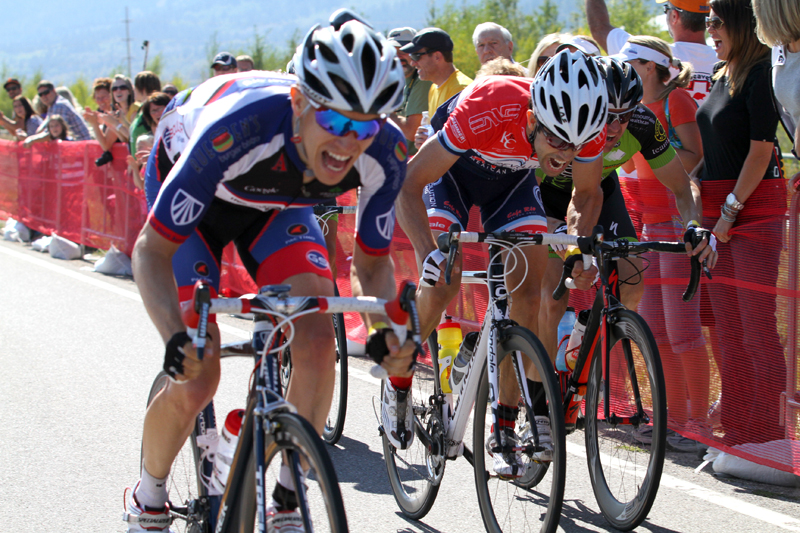
LoToJa is America’s longest, one-day sanctioned bicycle race from Logan, Utah to Jackson, Wyoming
Layton, Utah — Nearly 1,800 cyclists will ride 206 miles in one day from Logan, Utah to Jackson Hole, Wyoming in the 33rd Annual LoToJa Bicycle Classic on Sept. 12.
The 206-mile course features nearly 10,000 vertical feet of climbing across three mountain passes. Riders will start at a dawn at Sunrise Cyclery in Logan and will cross the finish line later that day at Jackson Hole Mountain Resort.
Before seeing the iconic Grand Teton at the finish, cyclists from the U.S. and foreign countries will ride on county and state roads in northern Utah, southeastern Idaho and western Wyoming. Along the way they’ll pass through Preston, Idaho and Montpelier, Idaho, and the Wyoming communities of Afton, Alpine and Hoback Junction.
“Except for the personal challenge that LoToJa represents, I think what attracts new riders, and brings cyclists back year after year, is LoToJa’s breathtaking scenery and the friendly communities through which the race passes,” said Race Director Brent Chambers of Epic Events. “The 206-mile course doesn’t have any big construction zones this year. It will be fascinating to see if last year’s new course record holds or gets broken.”
That new record of 8:45:38 was set last year by Cameron Hoffman of Clearfield, Utah. His average speed was over 23 mph. Melinda MacFarlane of Salt Lake City, Utah holds the current women’s record of 9:35:00. She set it in 2013 with an average speed of approximately 21 mph.
Most of the other cyclists usually cross the finish after 10 to 12 hours in the saddle. Despite LoToJa’s deep challenge to cyclists’ fitness and courage, many return year after year. At registration each spring, up to 4,000 applications are received — but less than 2,000 can be accepted because of permit limitations.
Chambers said that cyclists this year are coming from 40 states, some as far away as Florida and Hawaii. From outside the U.S., riders are coming from China and Great Britain; the majority, though, are from Utah and other western states.
“Most cyclists hear about LoToJa’s challenging distance and scenery and want to experience that,” he added. “It’s hard to beat seeing the Grand Teton coming in to the finish line. That is a big reward after a long day on a bicycle. The feeling of accomplishment is huge and lasts a lifetime.”
LoToJa began in 1983 by two Logan cyclists who wanted to create a bicycle race that resembled the difficulty of a one-day European spring classic like Paris-Roubaix, De Ronde van Vlaanderen or Liege-Bastogne-Liege.
In that first year, seven cyclists competed and crossed the finish line in Jackson. The winner was Bob VanSlyke of Logan who finished in just over 9 hours. Since then, LoToJa has become one of America’s premier amateur cycling races. It has also become a major fundraiser for the Huntsman Cancer Foundation, Autism Spectrum Disorder Connections, and other medical research foundations. To date, sponsors and participants have raised more than $1.4 million for these causes. In addition, LoToJa sponsors local fund-raising groups that assist the event.
This year’s race again serves multiple categories for USA Cycling license holders, plus a “Cyclosportive” class, which consists of non-licensed cyclists who are either competing against riders within their age group, or are just riding for fun. A relay race, and categories for tandem riders, will also be held.
LoToJa is the longest one-day bicycle race in America that is sanctioned by USA Cycling, the sport’s governing body. The age of cyclists range from 12 to 79 (14 to 84 in the relay category), and the average rider will burn up to 15,000 calories on race day — about a dozen large cheeseburgers with fries.
This year’s race will again have nearly 500 volunteers. Due to the mountainous and remote terrain, more than 150 volunteer ham radio operators from the Bridgerland Amateur Radio Club provide race communication.
“It wouldn’t be possible to put on LoToJa without the cooperation and assistance it receives from businesses, civic leaders, public safety officials and community volunteers,” said Chambers.
LoToJa’s top goal is to have a safe race for all cyclists, support crews and volunteers, he added. Motorists traveling LoToJa’s course on Sept. 12 are asked to use caution when approaching cyclists. Groups consisting of up to dozens of riders may be encountered. Motorists are urged to pass carefully and to leave a safe distance between their vehicle, cyclists and other traffic.
To further increase safety, on race day the Idaho Transportation Department will restrict eastbound traffic on Highway 36 north of Preston between Riverdale and Ovid from 7 a.m. to 12:30 p.m. Eastbound traffic on US-89 between Montpelier and the Wyoming state line will also be restricted from 9 a.m. to 2 p.m.
“We’ve been using the temporary travel restrictions for a few years because both highways are filled with eastbound LoToJa cyclists,” said Chambers. “Motorists are asked to use caution while traveling on these two roadways during LoToJa, and to anticipate encountering groups of cyclists. Cautious passing is advised to ensure safety for everyone.”
Cyclists who compete in the event, plus their support crews, well-wishers, event staff and volunteers, result in an entourage of approximately 4,500 people. Several of the communities through which LoToJa passes organize roadside fundraisers to capitalize on the influx of visitors. The host cities of Logan and Jackson also enjoy a welcomed economic boost from the race, specifically restaurants and motels.
It’s estimated more than 17,000 cyclists have pedaled over 4 million miles during LoToJa since the race began in 1983. Last year’s oldest male cyclist to finish was 74 years old and the oldest female was 63.
The youngest boy and girl finishers last year were 13 years old. The average age of a LoToJa participant is 42.
The route and additional information about the race are available at www.lotojaclassic.com.







